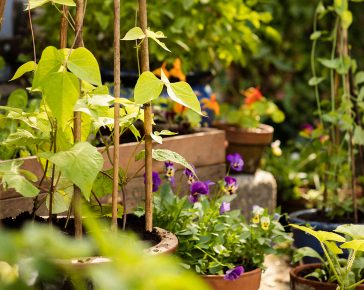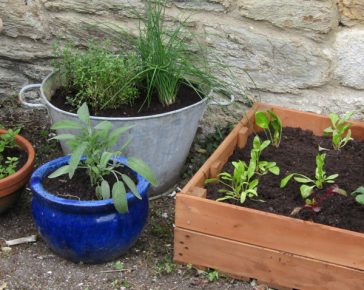There’s something very charming about growing veggies and herbs in a container garden. It’s a good way to get started, and an excellent way to grow your own if you have a patio garden, or limited space. There are a couple of other posts listed below as well, so have a read of these too.

Choosing Containers
We’d recommend gathering together a selection of containers of different shapes and sizes. This will give you more options when it comes to planting as different plants have different requirements (more on that below.)
Remember, you are not limited to ‘proper’ plant pots – an old wheelbarrow makes a good planter as does a stack of tyres. We’ve seen tomatoes being grown out of a pair of wellies, herbs in baked bean tins and salad leaves in a broken wok. The important thing is to make sure that whatever container you are using has drainage holes for excess water to seep out of.

Compost & Feed
A multi-purpose compost is a good choice for filling your containers. When you fill them, compact the compost down quite well, making sure the compost reaches to the top inch of the container.
Once your plants are growing, they will quickly use the nutrients in the compost so be sure to top up with a liquid feed every 4-6 weeks, or add a handful of wormcast fertiliser when planting (this will release nutrients slowly over the course of the summer)

Which plants?
As long as the pot is the right size for the plant, you can grow anything in containers. Here are some of the more popular veggies for different pot sizes – you will need to allow spacing as per our growing guide (e.g. if the growing guide suggest 20cm spacing, then only 1 plant per 20cm pot):
Window Boxes: Lettuces, Salad Leaves, Tiny Tim Tomato, Spring Onion
Small/Medium Deep Pots (e.g. 20-30cm wide): Leaves, Dwarf Beans, Tiny Tim Tomato, Aubergine, Pea, Curly Kale
Shallow Planters (e.g. 15cm deep): Beetroot, Turnip, Spring Onion, Leaves, Onion
Deep Planters (e.g 30cm deep): Courgette, Tomato, Climbing Bean, Chilli, Leek, Carrot, Parsnip, Cabbage, Cavolo Nero

Arranging your pots
You want to arrange your pots and containers in such a way that the taller plants and pots do not shade out the smaller ones. We find it useful to use logs or bricks to add height where necessary.
It is also good to intersperse your pots of veggies with pots of herbs and flowers – this will help a lot to attract pollinators as well as encouraging a wider bio-diversity that will help with pests.

Caring for your crops
Pots and containers tend to dry out faster during sunny spells, so you will need to water frequently. Try to keep the deeper soil consistently moist, allowing the top surface to dry out in between waterings.
You will still need to protect plants against some of the more common pests, like caterpillars, flea beetle and slugs. Slugs and snails tend to be a little easier to manage when growing in pots, but you will still need to check regularly – lift the pots and remove any that you find, and protect crops with copper tape or wool pellets if necessary.




